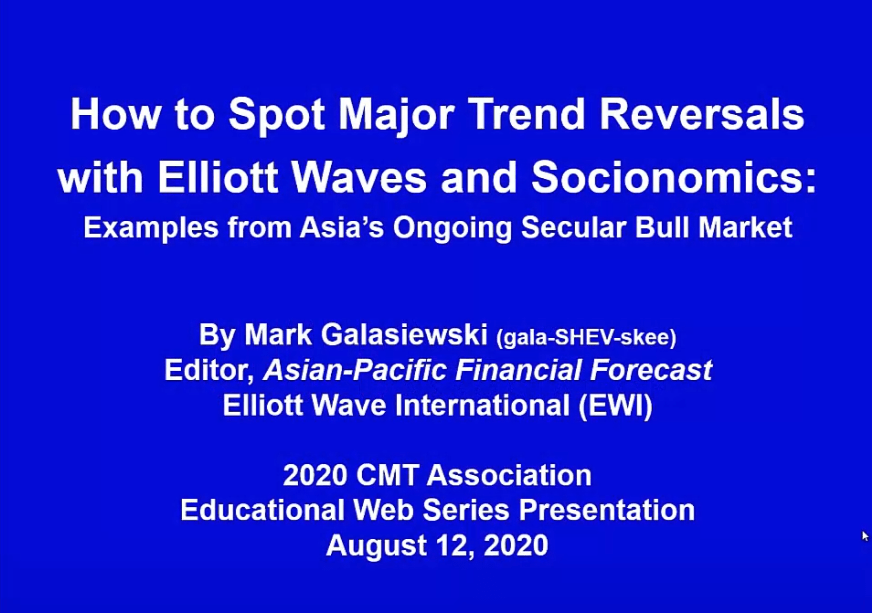
LETTER FROM THE EDITOR
In this month’s issue, we are confident we have something for everyone. Charlie Kirkpatrick, CMT, the only person to have written two Dow Award winning papers, explains an indicator he calls “the forward line.” In the first two articles of this issue, he explains the theory at the heart of the forward line, details the calculation of the indicator and demonstrates how to apply it to trading. In this month’s member interview, Anthony Abry explains his work and identifies position sizing and Commitment of Traders (COT) data as potential areas for further study. To help start your study, we turned to Ralph Vince who was the first to detail the theory of position sizing and John Kosar, CMT, who is one of the most innovative analysts working with COT data. We include some recent research from John and then added a chart showing how the market actually performed after John made his realtime market call. We conclude this issue with an article about market geometry by Scott Hathaway. Scott has been working on new geometric techniques, in some waysTo view this content you must be an active member of the TAN Association.
Not a member? Join the TAN Association and unlock access to hundreds of hours of written and video technical analysis content, including the Journal of Technical Analysis and the Video Archives. Learn more about Membership here.
What's Inside...
CYCLES AND THE FORWARD LINE
by Charles D. KirkpatrickEditor’s note: This information is adapted from Kirkpatrick’s Investment and Trading Strategies (Upper Saddle River, NJ: FT Press, 2014). It is copyrighted by the owner and is reprinted here with...
APPLYING CYCLES AND THE FORWARD LINE
by Charles D. KirkpatrickPlotting and Understanding Moving Averages Most of technical indicators require a period length. The MACD, Stochastic, CCI, DMI, ADX and ATR, etc., all require a length over which each is calculated....
DOW AWARD HIGHLIGHTS: CHARLES D. KIRKPATRICK II, CMT
The winner of the 1994 and 2001 Charles H. Dow Award, Charles D. Kirkpatrick II, CMT, is the only individual to win the award twice. Throughout his 45 years in the investment field, the national...
MIKE EPSTEIN AWARD 2014: PROFESSOR BLAKE LEBARON
In 2009, the MTA Educational Foundation established an annual award in memory of our late colleague, Mike Epstein. Each year, the award is presented to the person who best exemplifies Mike’s goals...
ANTHONY ABRY, MBA, CMT
by Anthony Abry, MBA, CMT & Amber Hestla-BarnhartHow would you describe your job? We help clients with research, development and trading strategy creation. We also reduce the manual workload needed for development and implementation of a strategy....
OPTIMAL F: CALCULATING THE EXPECTED GROWTH-OPTIMAL FRACTION FOR DISCRETELY-DISTURBED OUTCOMES
by Ralph VinceEditor’s note: This paper was originally published at RalphVince.com in June 2014 and is reposed here with permission. Repeatedly in both the gambling and trading communities the expected growth...
OIL PRICES: SMART MONEY SKEPTICAL AT $103 PER BARREL
by John Kosar, CMTEditor’s note: this was originally posted at Asbury Research on June 4, 2014 and is reposted here with permission. One of several investor asset-flow based investor sentiment metrics that we track...
BREAKOUT SIGNALS ON THE DOW AND S&P 500 PART TWO: SHORT-TERM BREAKOUTS CONFIRM THE EXPECTATION OF A CONTINUED MAJOR BULL MARKET
by Scott Hathaway, CFTeOverview In last month’s Technically Speaking, I showed a yearly log chart of the Dow demonstrated the market’s attempt at a potential breakout of resistance for 2014 which, if successful, would...
Editor’s note: This information is adapted from Kirkpatrick’s Investment and Trading Strategies (Upper Saddle River, NJ: FT Press, 2014). It is copyrighted by the owner and is reprinted here with permission.
In recognition of my receipt of two Dow Awards, the MTA’s Mike Carr, CMT and Emily Meyer asked if I would provide information on recent research of interest to technical analysts. They specifically requested information on what I call the “Forward Line” – its basis, how it is calculated, and how it is used. In that regard, I found that the easiest way to describe this phenomenon, without extraordinary effort, was to provide an abbreviated version of Chapter 8 (“Cycles and the Forward Line”) in my book Kirkpatrick’s Investment and Trading Strategies.[1]
When I was first involved in technical analysis in the 1960s, looking for patterns in the price charts was the basic means of analyzing stocks or any other, freely-traded
To view this content you must be an active member of the TAN Association.
Not a member? Join the TAN Association and unlock access to hundreds of hours of written and video technical analysis content, including the Journal of Technical Analysis and the Video Archives. Learn more about Membership here.
Contributor(s)

Charles D. Kirkpatrick
Charles Kirkpatrick, who holds the Chartered Market Technician (CMT) designation, is the president of Kirkpatrick & Company, Inc., and has been a featured speaker before such professional organizations as the New York Society of Security Analysts, Financial Analysts Federation,...
Plotting and Understanding Moving Averages
Most of technical indicators require a period length. The MACD, Stochastic, CCI, DMI, ADX and ATR, etc., all require a length over which each is calculated. Different lengths in indicators have different results. It is important that the length of an indicator is related to the price action of the stock. Most indicators have their standard lengths, but in many cases these standards were not developed by any investigative approach. Most of the standards were developed before the advent of the computer and because they were easy to calculate on an adding machine. I’ve found instead that indicator lengths should be directly related to the cycle period of the prices being investigated. It is therefore imperative that I have a means of quantifying a cycle period. Underlying all my studies is recognizing what cycles are occurring in the market, and to profit from them, I need
To view this content you must be an active member of the TAN Association.
Not a member? Join the TAN Association and unlock access to hundreds of hours of written and video technical analysis content, including the Journal of Technical Analysis and the Video Archives. Learn more about Membership here.
Contributor(s)

Charles D. Kirkpatrick
Charles Kirkpatrick, who holds the Chartered Market Technician (CMT) designation, is the president of Kirkpatrick & Company, Inc., and has been a featured speaker before such professional organizations as the New York Society of Security Analysts, Financial Analysts Federation,...
The winner of the 1994 and 2001 Charles H. Dow Award, Charles D. Kirkpatrick II, CMT, is the only individual to win the award twice. Throughout his 45 years in the investment field, the national media and his peers have recognized Charles D. Kirkpatrick II. He has been featured on Wall $treet Week, CNBC, and in the magazine Technical Analysis of Stocks and Commodities, has been quoted in such publications as The Wall Street Journal, BusinessWeek, Forbes, Futures magazine, Money magazine and The New York Times, and has written articles for Barron’s and the Market Technicians Journal. He is the only person to win the annual Charles H. Dow Award twice, for articles on technical analysis in 1993 and 2001. In 2008, he won the Market Technicians Association Annual Award for “outstanding contributions to the field of technical analysis.”
He has been
To view this content you must be an active member of the TAN Association.
Not a member? Join the TAN Association and unlock access to hundreds of hours of written and video technical analysis content, including the Journal of Technical Analysis and the Video Archives. Learn more about Membership here.
In 2009, the MTA Educational Foundation established an annual award in memory of our late colleague, Mike Epstein. Each year, the award is presented to the person who best exemplifies Mike’s goals for long-term sponsorship of technical analysis in academia and in practice.
The original mission of the MTA Educational Foundation was to create and fund educational programs in the field of technical analysis. Throughout the years, this mission has expanded to include the creation and support of a complete Technical Analysis curriculum that is now being taught in colleges and universities for college credit.
Fulfilling these goals would not be possible without dedicated partners from academia. Advocates on the university side are critical for not only teaching what we already know about technical analysis but forging new ground in the field that we can pass on to the next generation to put
To view this content you must be an active member of the TAN Association.
Not a member? Join the TAN Association and unlock access to hundreds of hours of written and video technical analysis content, including the Journal of Technical Analysis and the Video Archives. Learn more about Membership here.
How would you describe your job?
We help clients with research, development and trading strategy creation. We also reduce the manual workload needed for development and implementation of a strategy. We develop strategies, backtest and optimize them, and get a full understanding on the character of the strategy. We know when it has failed vs. when it is in a drawdown (or too high profit zone).
For implementation, a client might have 5 big strategies with 20 sub strategies. They are end of day strategies and need to be updated daily. A report needs to be sent out as well to some signal generating service distributor. We develop the tools to make this possible with as few clicks as necessary. The data gets updated, the strategies update, the report gets generated with just a few clicks.
Everything is quantified and developed in-house. Our main workhorse is Amibroker which we might extend with various
To view this content you must be an active member of the TAN Association.
Not a member? Join the TAN Association and unlock access to hundreds of hours of written and video technical analysis content, including the Journal of Technical Analysis and the Video Archives. Learn more about Membership here.
Contributor(s)

Anthony Abry, MBA, CMT
Anthony Abry, MBA, CMT is the owner and co-founder of Instat Research, a firm which helps institutional and retail clients develop trading strategies. Current internal R&D is focused on development and implementation of trading strategies tools, such as automated...

Amber Hestla-Barnhart
Editor’s note: This paper was originally published at RalphVince.com in June 2014 and is reposed here with permission.
Repeatedly in both the gambling and trading communities the expected growth optimal fraction is employed, often referred to as the Kelly Criterion, and referring to the 1956 paper of John L. Kelly [2]. Though applicable in many gaming situations (though not all, blackjack being a prime example [15]) where the most that can be lost is the amount wagered, the Kelly Criterion solution is not directly applicable to trading situations which are more complicated.
Take for example a short sale. Clearly what can be lost is not the same as the price of the stock. Forex transactions incur a different analysis as one is long a currency specified in another currency (and thus vice-versa in effect, short that other currency against the long currency). Commodity futures represent a different problem than simply being long
To view this content you must be an active member of the TAN Association.
Not a member? Join the TAN Association and unlock access to hundreds of hours of written and video technical analysis content, including the Journal of Technical Analysis and the Video Archives. Learn more about Membership here.
Contributor(s)

Ralph Vince
Ralph Vince is a technical analyst and computer programmer writing analytical programs for funds, large traders and professional gamblers. He is the author of five books on investing in his field of expertise, portfolio management and portfolio/trade optimization. In his latest...
Editor’s note: this was originally posted at Asbury Research on June 4, 2014 and is reposted here with permission.
One of several investor asset-flow based investor sentiment metrics that we track is the weekly Commitments of Traders (CoT) data.
The CoT data, compiled and published by the Commodity Futures Trading Commission (CFTC), breaks down futures open interest to determine and disclose how several different types of investor are positioned in the marketplace.
One COT data series that has caught our attention recently is the current positioning of the Commercial Hedger and Large Speculator categories in crude oil futures.
First, a little background information. Commercial hedgers are large traders who also deal in the commodity on a cash basis, which in this case would include oil producers. These entities typically accumulate a net position against the trend, to hedge their physical interest in the commodity. Think of them as value barometers. More specifically, this group
To view this content you must be an active member of the TAN Association.
Not a member? Join the TAN Association and unlock access to hundreds of hours of written and video technical analysis content, including the Journal of Technical Analysis and the Video Archives. Learn more about Membership here.
Contributor(s)

John Kosar, CMT
John Kosar, CMT, is the Chief Market Strategist of Asbury Research LLC, a firm he launched in 2005. Asbury Research provides a blend of technical and quantitative investment research to both institutional and private investors. In addition, John is also the Chief Investment...
Overview
In last month’s Technically Speaking, I showed a yearly log chart of the Dow demonstrated the market’s attempt at a potential breakout of resistance for 2014 which, if successful, would indicate a continued major bull market. In addition, I offered evidence that unless November signaled a false breakout by closing below monthly geometric resistance, the markets would embark on the continued large rally, and offered two price/time targets in the short-term for the Dow.
Part Two offers long-term targets for the Dow, and the S&P 500. I will present and implement a square root support line technique which explains the two preceding major top areas of 2000 and 2007 in both price and time, and is thus continued forward and combined for speculative top areas.
I have decided to offer the geometric and parabolic work originally intended for this month’s article in a third installment. This will include sequential geometric analysis that
To view this content you must be an active member of the TAN Association.
Not a member? Join the TAN Association and unlock access to hundreds of hours of written and video technical analysis content, including the Journal of Technical Analysis and the Video Archives. Learn more about Membership here.
Contributor(s)

Scott Hathaway, CFTe
Scott Hathaway, CFTe is the Co-Founder and Manager of Pattern to Profit, LLC, a new independent technical investment research firm utilizing unique geometric analysis of global markets. A musician by trade, Scott committed to the constant study, exploration and...
New Educational Content This Month
-
August 26, 2020
The CMT Experience
Presenter(s): Tyler Wood, Dave Lundgren, CMT, CFA
-
August 26, 2020
Reading the Current Market in Light of History’s Lessons
Presenter(s): Ryan Detrick, CMT
-
August 12, 2020
How to Spot Major Trend Reversals with Elliott Waves and Socionomics: Examples from Asia’s Ongoing Secular Bull Market
Presenter(s): Mark Galasiewski





